![]()
![]()
![]()
Use LEFT and RIGHT arrow keys to navigate between flashcards;
Use UP and DOWN arrow keys to flip the card;
H to show hint;
A reads text to speech;
113 Cards in this Set
- Front
- Back
|
Asexual reproduction
|
The reproduction of cells or single-celled organisms by cell division; offspring are clones of the parent.
|
|
|
Clone |
An individual that carries an exact copy of the nuclear genome of another individual; clones are genetically identical cells or individuals.
|
|
|
Binary Fission
|
bacteria and archaeons reproduce by binary fission, a form of cell division in which the genome replicates and then the cell divides in two. The result is two cells that are either identical to the parent cell or nearly identical, differing only because of chance mutations.
|
|
|
Budding
|
A form of asexual reproduction in fungi, plants, and some animals in which a bud forms on the organism and eventually breaks off to form a new organism that is smaller than its parent.
|
|
|
Fragmentation
|
A form of asexual reproduction in which new individuals arise by the splitting of one organism into pieces, each of which develops into a new individual.
|
|
|
Parthenogenesis
|
A form of asexual reproduction in which females produce eggs that are not fertilized by males but divide by mitosis and develop into new individuals.
|
|
|
Sexual Reproduction
|
The process of producing offspring that receive genetic material from two parents; in eukaryotes, the process occurs through meiosis and fertilization
|
|
|
Meiotic Cell Division
|
A form of cell division that includes only one round of DNA replication but two rounds of nuclear division; meiotic cell division makes sexual reproduction possible.
|
|
|
Fertilization
|
The union of gametes to produce a diploid zygote.
|
|
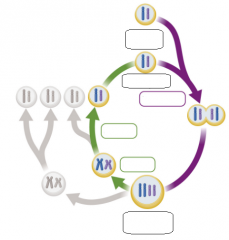
|
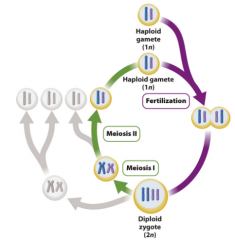
|
|
|
Gamete
|
A reproductive haploid cell; gametes fuse in pairs to form a diploid zygote. In many species, there are two types of gametes: eggs in females, sperm in males.
|
|
|
Spore |
A reproductive cell capable of growing into a new individual without fusion with another cell.
|
|
|
Spermatozoa (Sperm)
|
The smaller, male gametes.
|
|
|
Ovum (Egg)
|
The larger, female gamete.
|
|
|
Zygote
|
The diploid cell formed by the fusion of two gametes.
|
|
|
Embryo
|
An early stage of multicellular development that results from successive mitotic divisions of the zygote.
|
|
|
Sexual reproduction results in offspring that are genetically different from one another and from their parents. Describe four mechanisms that produce this genetic variation. Do any of these mechanisms occur in asexual reproduction?
|
Sexual reproduction generates genetically unique offspring by (1) chance mutations; (2) recombination between homologous chromosomes during meiosis I; (3) random segregation of homologous chromosomes during meiosis I; and (4) new combinations of chromosomes in the process of fertilization. Asexual reproduction, like sexual reproduction, is subject to chance mutations.
|
|
|
What determines when an organism reproduces sexually and when it reproduces asexually?
|
Reproduces asexually by parthenogenesis in the spring, when food is plentiful, perhaps because asexual reproduction is a rapid form of reproduction that allows the organism to take advantage of abundant resources. Later in the season, when conditions are less favorable because of increased crowding and decreased food and temperature, sexual reproduction is favorable to produce a zygote that starts to form an embryo. At an early stage, however, development is arrested and metabolism slows dramatically. The embryo forms a thick-walled structure, called a cyst, which enables it to resist freezing and drying, allowing it to make it through the winter.
|
|
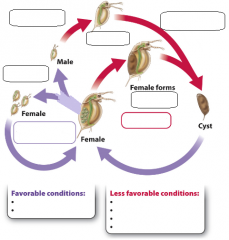
|
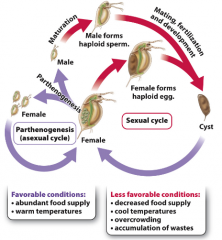
|
|
|
Twofold Cost of Sex
|
Population size can increase more rapidly in asexually reproducing organisms than in sexually reproducing organisms because only female produce offspring, and sexual females have only half the fitness of asexual parents.
|
|
|
External Fertilization
|
Fertilization that takes place outside the body of the female; in aquatic organisms, for example, eggs and sperm are released into the water.
|
|
|
Internal Fertilization
|
Fertilization that takes place inside the body of the female.
|
|
|
R-Strategist
|
A species that produces large numbers of offspring but provides few resources for their support.
|
|
|
K-Strategist
|
A species that produces relatively few young but invests considerable resources into their support
|
|
|
Yolk
|
A substance in the eggs of animals with external fertilization that provides all the nutrients that the developing embryo needs until it hatches.
|
|
|
Amnion
|
In the amniotic egg, a membrane surrounding a fluid-filled cavity that allows the embryo to develop in a watery environment.
|
|
|
Allantois
|
In the amniotic egg, a membrane that encloses a space where metabolic wastes collect.
|
|
|
Chorion
|
In the amniotic egg, a membrane that surrounds the entire embryo along with its yolk and allantoic sac.
|
|
|
Extraembryonic Membrane
|
In the amniotic egg, one of several sheets of cells that extend out from the developing embryo and form the yolk sac, amnion, allantois, and chorion.
|
|
|
The Evolution of the Amnion.
|
The amnion is a membrane enclosing a fluid-filled cavity surrounding the developing embryo that evolved during the transition from water to land.
|
|
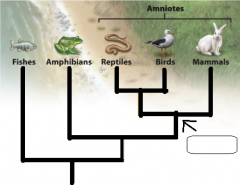
|
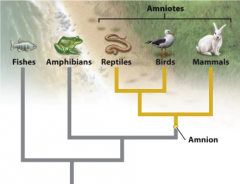
|
|
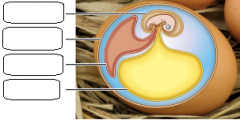
|
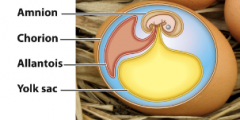
|
|
|
Oviparity
|
Laying eggs. (Egg Birth). Used by most insects, fish, amphibians, and reptiles, as well as all birds. There is very little, if any, embryonic development inside the mother, and all the nutrients for the developing embryo come from the yolk.
|
|
|
Ovoviviparity
|
Giving birth to live young(Egg Live Birth) with nutritional support of the embryo from the yolk. Differ in where they get their nourishment during embryonic development. In some animals, embryos develop inside eggs that are retained inside the mother until they hatch. These embryos receive nutritional support from the yolk, not from the mother. Some sharks and snakes are ovoviviparous.
|
|
|
Viviparity
|
Giving birth to live young, with nutritional support of the embryo from the mother. The embryo develops inside the mother and receives all its nourishment from the mother. The chorion and allantois fuse to form the placenta.
|
|
|
Placenta
|
In placental mammals, an organ formed by the fusion of the chorion and allantois that allows the embryo to obtain nutrients directly from the mother.
|
|
|
Gonads
|
In mammals, the part of the reproductive system where haploid gametes are produced. Male gonads are testes, where sperm are produced. Female gonads are ovaries, where eggs are produced.
|
|
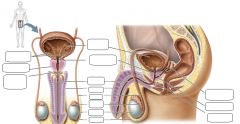
|
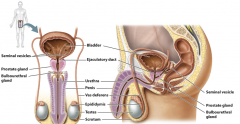
|
|
|
Acrosome
|
An organelle that surrounds the head of the sperm containing enzymes that enable sperm to transverse the outer coating of the egg.
|
|
|
Flagellum
|
An organelle that propels the movement of cells or of substances within cells; longer than a cilium.
|
|
|
Scrotum
|
A sac outside the abdominal cavity of the male that holds the testes.
|
|
|
Seminiferous Tubules
|
A series of tubes in the testes where sperm are produced.
|
|
|
Epididymis
|
An organ that lies above the testes where sperm become motile and are stored prior to ejaculation.
|
|
|
Vas Deferens
|
A long, muscular tube from the scrotum, through the abdominal cavity, along the bladder, and connecting with the ejaculatory duct.
|
|
|
Ejaculatory Duct
|
The duct through which sperm travel from the vas deferens to the urethra
|
|
|
Urethra
|
A tube from the bladder that in males carries semen as well as urine from the body.
|
|
|
Prostate Gland
|
An exocrine gland that produces a thin, slightly alkaline fluid that helps maintain sperm motility and counteracts the acidity of the female reproductive tract.
|
|
|
Bulbourethral Glands
|
Glands below the prostate gland that produce a clear fluid that lubricates the urethra for passage of the sperm.
|
|
|
What effect would cutting the vas deferens on both sides and tying off the ends have on male fertility?
|
The vas deferens carries sperm from the epididymis to the ejaculatory duct. Cutting the vas deferens on both sides prevents sperm from entering the ejaculatory duct and leads to male sterility. This procedure, called a vasectomy, is a method of male contraception.
|
|
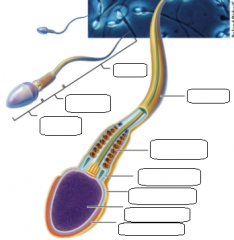
|
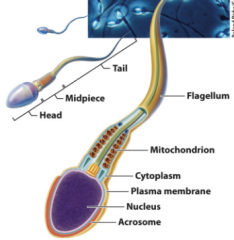
|
|
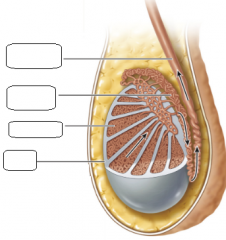
|

|
|
|
Oocyte
|
The unfertilized egg cell produced by the mother; the developing female gamete.
|
|
|
Fallopian Tube (Oviduct)
|
A tube from each ovary, through one of which a released oocyte passes.
|
|
|
Uterus
|
A hollow organ within the reproductive tract of female mammals with thick, muscular walls that is adapted to support the developing embryo if fertilization occurs and to deliver the baby during birth.
|
|
|
Cervix
|
The end, or neck, of the uterus.
|
|
|
Vagina
|
A tubular channel connecting the uterus to the exterior of the body; also known as the birth canal.
|
|

|
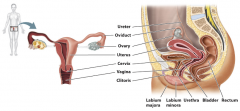
|
|
|
Gonadotropin-Releasing Hormone (GnRH)
|
A hormone released by the hypothalamus that stimulates the anterior pituitary gland to secrete luteinizing hormone and follicle-stimulating hormone.
|
|
|
Luteinizing Hormone (LH)
|
A hormone secreted by the anterior pituitary gland that stimulates the male and female gonads to secrete testosterone in males and estrogen and progesterone in females.
|
|
|
Follicle-Stimulating Hormone (FSH) |
A hormone secreted by the anterior pituitary gland that stimulates the male and female gonads to secrete testosterone in males and estrogen and progesterone in females.
|
|
|
Testosterone
|
A steroid hormone, secreted by the testes, that plays key roles in male growth, development, and reproduction.
|
|
|
Estrogen
|
A hormone secreted by the ovaries that stimulates the development of female secondary sexual characteristics.
|
|
|
Progesterone
|
A hormone secreted by the vertebrate ovaries that maintains the thickened and vascularized uterine lining.
|
|
|
Leydig Cell
|
A type of cell in the testes that secretes testosterone.
|
|
|
Sertoli Cell
|
A type of cell in the seminiferous tubules that supports sperm production.
|
|
|
Menstrual Cycle
|
A monthly cycle in females in which oocytes mature and are released from the ovary under the influence of hormones.
|
|
|
Follicular Phase
|
The phase of the menstrual cycle during which FSH acts on granulosa cells, resulting in the maturation of several oocytes, of which, usually, only one becomes completely mature.
|
|
|
Luteal Phase
|
The phase of the menstrual cycle beginning with ovulation.
|
|
|
Follicle
|
A type of cell that makes up the shell of cells surrounding an oocyte that supports the developing oocyte.
|
|
|
Corpus Luteum |
A temporary endocrine structure that secretes progesterone.
|
|
|
Human Chorionic Gonadotropin (hCG)
|
A hormone released by the developing embryo that maintains the corpus luteum.
|
|
|
Menstruation
|
The monthly shedding of the uterine lining.
|
|
|
Menopause
|
The cessation of menstrual cycles resulting from decreased production of estradiol and progesterone by the ovaries.
|
|
|
Estrus Cycle
|
A cycle in placental mammals other than humans and chimpanzees characterized by phases in which females are sexually receptive.
|
|
|
A monthly course of an oral contraceptive pill is usually three weeks of hormone pills followed by one week of placebo (a sugar pill with no hormone). Why do you think the placebos are sometimes used?
|
High levels of estrogen and/or progesterone lead to the growth of the uterine lining. The drop in these hormones while a woman is taking placebos allows the uterine lining to be shed each month. Placebos are usually taken instead of no pills in order to help keep track of the number of days before resuming hormone-containing pills.
|
|
|
Gametogenesis
|
The formation of gametes.
|
|
|
Spermatogenesis
|
The formation of sperm.
|
|
|
Primary Spermatocyte
|
A diploid cell formed by mitotic division of spermatogonia at the beginning of spermatogenesis.
|
|
|
Secondary Spermatocyte
|
A diploid cell formed during the first meiotic division of the primary spermatocyte.
|
|

|

|
|

|

|
|
|
Oogenesis
|
The formation of ova or eggs.
|
|
|
Primary Oocyte
|
A diploid cell formed by mitotic division of oogonia during fetal development.
|
|
|
Secondary Oocyte
|
A large cell produced by the asymmetric first meiotic division of the primary oocyte.
|
|
|
Polar Body
|
A small cell produced by the asymmetric first meiotic division of the primary oocyte.
|
|
|
When are primary oocytes and spermatocytes produced, and how many gametes result from one diploid cell in females and males?
|
In females, oogonia differentiate into primary oocytes before birth and therefore a female is born with all the primary oocytes she will have. In males, by contrast, spermatogonia do not differentiate into primary spermatocytes until puberty, but sperm can be produced throughout a male’s lifetime. Only one of the four products of meiosis becomes a gamete in females, whereas all four products of meiosis become sperm in males.
|
|
|
Capacitation
|
A series of physiological changes that allow the sperm to fertilize the egg.
|
|
|
Polyspermy
|
In animals, fertilization by more than one sperm.
|
|
|
In Vitro Fertilization (IVF)
|
A process in which eggs and sperm are brought together in a petri dish, where fertilization and early cell divisions occur.
|
|
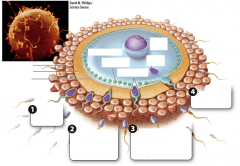
|
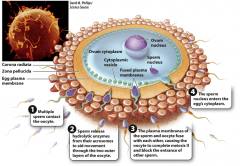
|
|
|
Cleavage
|
The successive mitotic divisions of the zygote after fertilization, in which the single large egg is divided into many smaller cells.
|
|
|
Blastula
|
A fluid-filled ball of undifferentiated cells formed after the fertilized egg has undergone several rounds of mitotic cell division following the morula stage.
|
|
|
Trimesters
|
The three periods of pregnancy, each lasting about 3 months. The first trimester includes cleavage, gastrulation, and organogenesis.
|
|
|
Gastrulation
|
A highly coordinated set of cell movements in which the cells of the blastoderm migrate inward, creating germ layers of cells within the embryo.
|
|
|
Germ Layers
|
Three sheets of cells, the ectoderm, mesoderm, and endoderm, formed by migrating cells of the gastrula that differentiate further into specialized cells.
|
|
|
Ectoderm
|
The outer germ layer, which differentiates into epithelial cells, pigment cells in the skin, nerve cells in the brain, and the cornea and lens of the eye.
|
|
|
Mesoderm
|
The intermediate germ layer, which differentiates into cells that make up connective tissue, muscle cells, red blood cells, bone cells, kidney cells, and gonad cells.
|
|
|
Endoderm
|
The germ layer that differentiates into cells of the lining of the digestive tract and lung, liver cells, pancreas cells, and gallbladder cells.
|
|
|
Organogenesis
|
The transformation of the three germ layers into all the organ systems of the body.
|
|
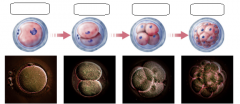
|
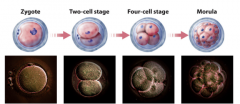
|
|
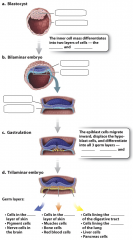
|

|
|

|

|
|
|
A multicellular organism starts off as a single cell, which divides by mitosis to produce many cells. Therefore, for the most part, all the cells in a multicellular organism are genetically identical—they are clones—yet in time different groups of cells look different and function quite differently from one another. How can this be?
|
In the process of development, cells differentiate into different cell types. The process of differentiation involves the turning on and turning off of specific genes. So, for example, genes that are expressed in a skin cell are different from those that are expressed in a liver or muscle cell. These changes in gene expression, once established, are for the most part stable through mitotic cell divisions.
|
|
|
List similarities and differences between asexual and sexual reproduction.
|
Asexual and sexual reproduction are two ways that organisms can reproduce. They both provide a way for a parent to transmit genetic information to a new generation. In asexual reproduction, a single individual will divide in two, bud, or fragment, forming genetically identical clones. In contrast, in sexual reproduction, two genetically different organisms will come together to form a genetically unique progeny. The process of mitosis happens in both forms of reproduction, whereas meiosis only happens with sexual reproduction.
|
|
|
Explain the roles of meiotic cell division and fertilization in sexual reproduction.
|
The role of meiosis in sexual reproduction is to create gametes or spores containing half the amount of chromosomes as the parent organism. Fertilization is the fusion of two gametes or spores, and restores the original chromosome content of the parent organisms. Both processes contribute to genetic variation in the offspring.
|
|
|
Describe the costs and benefits of asexual and of sexual reproduction.
|
Asexual reproduction eliminates the need for the organism to find and attract a mate, which takes time and energy. It is also rapid, allowing organisms to increase their numbers quickly, often exponentially. However, asexual reproduction does not introduce genetic variability—the only source of genetic variation in asexual reproduction is chance mutations—and therefore may have dire evolutionary consequences. Sexual reproduction exacts costs in terms of energy expenditure and the rate of population growth, but the benefit is that it produces offspring that are genetically different from one another and from their parents.
|
|
|
Provide an explanation for the observation that there are very few, if any, ancient asexual organisms.
|
There are few, if any, ancient asexual organisms because a certain amount of genetic variability is favored. For a population to adapt, there must be a higher rate of genetic variability than just random mutation alone. Sexual reproduction gives these populations the level of genetic diversity they need in order to be evolutionarily fit.
|
|
|
Name three adaptations that allow reproduction to take place on land.
|
Reproduction requires an aqueous environment, so the movement onto land required a number of adaptations. Internal fertilization, oviparity (in particular, the development of the amnion), and viviparity are all adaptations that allow reproduction to take place on land because they avoid having the processes of fertilization and development occur in the terrestrial environment.
|
|
|
Describe the pathway of sperm from its site of production to the urethra.
|
Sperm are produced within the testes in the seminiferous tubules, and then travel through the epididymis, vas deferens, ejaculatory duct, and finally the urethra.
|
|
|
Describe the pathway of an oocyte (and the egg it develops into) from its site of production to the uterus.
|
Oocytes are produced in the ovaries and then travel through the fallopian tubes to the uterus.
|
|
|
Explain the relationships among changes in levels of anterior pituitary and ovarian hormones, oocyte development, and changes in the uterine lining during a menstrual cycle.
|
In females, the anterior pituitary gland secretes luteinizing hormone (LH) and follicle-stimulating hormone (FSH), in a cyclical pattern. FSH acts on granulosa cells in the follicles of the ovary, causing oocyte maturation. The granulosa cells also secrete estradiol (a form of estrogen), which stimulates a surge of LH from the anterior pituitary that, in turn, triggers release of the mature oocyte from the ovary, or ovulation. Estradiol also causes the uterine lining to thicken, and the corpus luteum (a structure formed by the follicle cells after oocyte release) secretes progesterone, which helps maintain the thickened uterine lining. If the oocyte is fertilized, it implants into the uterine lining and secretes human chorionic gonadotropin (hCG), which maintains the corpus luteum and hence the thickened uterine lining. Eventually, the placenta takes over estrogen and progesterone production to maintain the uterine lining and stimulate the growth of the uterus. If the oocyte is not fertilized, the corpus luteum degenerates, estrogen and progesterone levels drop, and the uterine lining is shed.
|
|
|
Describe similarities and differences between male and female gametogenesis.
|
Male and female gametogenesis are similar in that a primordial germ cell undergoes mitotic and meiotic cell divisions to form a primary spermatocyte or oocyte, but there are striking differences in timing, and the number of gametes produced from each parental diploid cell. In spermatogenesis, the primary spermatocyte undergoes meiosis I and II to form four haploid sperm cells. Spermatogenesis begins at puberty and continues throughout life, and the entire process takes 2‒3 months. In contrast, oogenesis begins in the developing female embryo, with formation of primary oocytes. The primary oocytes enter the first meiotic division, but arrest immediately in prophase I. By the time the female is born, she has 1‒2 million primary oocytes arrested in prophase I. These cells remain arrested for at least 12 years (until the age of menarche) and up to 50 years (until the age of menopause). A primary oocyte completes its first round of meiotic division during each menstrual cycle; the asymmetric cell division produces one secondary oocyte and one polar body. The secondary oocyte enters the second meiotic division, but arrests in metaphase II until fertilization takes place. Again, the division is asymmetric, producing one ovum and one polar body. Thus, in contrast to spermatogenesis, in oogenesis the primary oocyte undergoes two rounds of meiosis but only produces one viable ovum. The other three cells are polar bodies and remain arrested in the metaphase II phase.
|
|
|
Name and describe three key developmental steps in the development of a single-celled zygote to a multicellular individual.
|
Three key developmental steps in the development of a single-celled zygote to a multicellular individual are cleavage, gastrulation, and organogenesis. Cleavage is where the single-celled zygote divides by mitosis. This divides the single large zygote into many smaller cells without increasing the zygote’s size. Gastrulation is a highly coordinated set of cell movements that leads to a fundamental reorganization of the embryo into three germ layers. Organogenesis is the transformation of the three germ layers into all the organ systems of the body.
|

